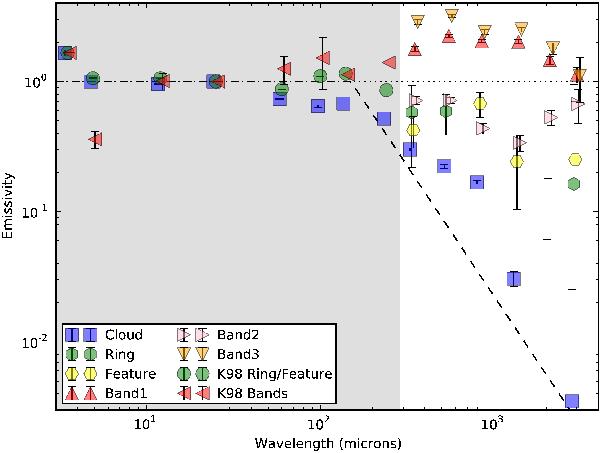Fig. 9

Emissivities of components of the K98 zodiacal emission model obtained from Planck/HFI (λ> 250 μm) and COBE/DIRBE (λ ≤ 250 μm, grey shading; K98). The diffuse cloud is shown as blue squares. For DIRBE, all dust bands (red, left-pointing triangles) were assumed have the same emissivity. For HFI, the bands (red, up-pointing triangles for Dust Band 1; pink, right-pointing triangles for Dust Band 2; and orange, down-pointing triangles for Dust Band 3) were allowed to have different emissivities. Similarly, K98 assumed that the circumsolar ring and Earth-trailing feature (green circles) had the same emissivities. For Planck the circumsolar ring (green hexagons) and Earth-trailing feature (yellow hexagons) were allowed to be different. Planck values were obtained by fitting an amplitude to each component, as well as the Galaxy seen through the sidelobes. All other parameters in the model were fixed at their K98 values. Each point is the average of the corresponding values obtained for all individual horns and surveys at the given frequency, over the first two years of HFI data (grey-shaded regions in each panel of Fig. 8. Error bars give the standard errors of these different measures. Numerical values are given in Table 2. Note that a few cloud, circumsolar ring, and Earth-trailing feature values are negative, and so do not appear in this log–log plot. In such cases, the upper limit will appear as a short horizontal line. The dotted line indicates an emissivity of unity at all wavelengths, and the dashed line indicates an emissivity that is unity at wavelengths below 150 μm and proportional to λ-2 at longer wavelengths.
Current usage metrics show cumulative count of Article Views (full-text article views including HTML views, PDF and ePub downloads, according to the available data) and Abstracts Views on Vision4Press platform.
Data correspond to usage on the plateform after 2015. The current usage metrics is available 48-96 hours after online publication and is updated daily on week days.
Initial download of the metrics may take a while.


